A History of the County of York North Riding: Volume 2. Originally published by Victoria County History, London, 1923.
This free content was digitised by double rekeying. All rights reserved.
'Parishes: Brafferton', in A History of the County of York North Riding: Volume 2, ed. William Page (London, 1923), British History Online https://prod.british-history.ac.uk/vch/yorks/north/vol2/pp98-103 [accessed 19 April 2025].
'Parishes: Brafferton', in A History of the County of York North Riding: Volume 2. Edited by William Page (London, 1923), British History Online, accessed April 19, 2025, https://prod.british-history.ac.uk/vch/yorks/north/vol2/pp98-103.
"Parishes: Brafferton". A History of the County of York North Riding: Volume 2. Ed. William Page (London, 1923), British History Online. Web. 19 April 2025. https://prod.british-history.ac.uk/vch/yorks/north/vol2/pp98-103.
In this section
BRAFFERTON
Bratfortune, Bradfortune (xi cent.); Braferton, Brafferton (xiii cent.).
The parish of Brafferton, including the townships of Helperby and Thornton Bridge, covers 5,015 acres of land on either side of the River Swale and some 16 miles north of York. The land lies low, being but 50 ft. above ordnance datum by the Swale, but rises towards the north-east, where it reaches about 87 ft. on Pilmoor. The subsoil is alluvium and the soil varies; there is clay in the north of the parish, where brick and tile works are established, and old gravel-pits near Thornton Bridge, while the land about Helperby is especially suitable for barley, and there are maltings and a brewery in the village. In the whole parish 2,131 acres are arable land and 1,497 acres are laid down to grass. (fn. 1) The woods, which cover 331 acres, lie chiefly in the north and east, Brafferton Spring being of considerable size and a noted fox covert.
Brafferton and Helperby lie together and form one large village on the east bank of the Swale, Brafferton being to the north and Helperby to the south. The villages are built at the crossing of two ancient roads, the High Lane leading north to Topcliffe and south to York, and Wath or Helperby Lane running east to Raskelf and south-west to Boroughbridge. This last road crosses the Swale by an ancient ford (fn. 2) and ferry, whence paths across the open Swale Green lead directly to the west end of the village street.
Brafferton Manor, the residence of Mr. T. N. Driffield, J.P., stands at the north-east end of the village. Brafferton Hall, the dower-house of the Coates family, adjoins the church and is the residence of Mr. Simeon Marshall. The church stands on rising ground on the north-west of the village and between it and the Swale, while the school (fn. 3) and the vicarage are near at hand; but, though the church is at the Brafferton end, most of the houses are included in Helperby, (fn. 4) and built along High Lane, with the usual Back Lane to the east. The wide village street is planted with trees, and boasts an institute, reading room and almshouse, all built by Mr. James Coates, who also gave the fountain under a roof at the cross-roads in commemoration of the Diamond Jubilee of Queen Victoria. The Wesleyan chapel was built in 1888 and is late Gothic in character. At the south end of the village street stands Helperby Hall, the residence of Sir Edward F. Coates, bart., M.P., D.L., J.P., which may date originally from the close of the 17th century, but has been much enlarged and altered. It is noted for its two beautiful yew gardens. Opposite is the private cricket ground used by the villagers. A little further south, on the way to York, stands Helperby Grange, owned by Sir E. F. Coates.
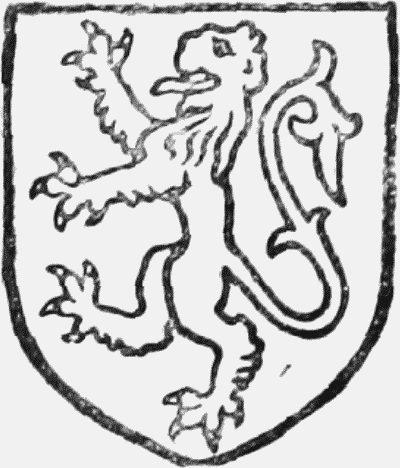
Helperby Hall, Brafferton
About a mile north-west of Brafferton the road to Topcliffe crosses the Swale by an iron bridge called Thornton Bridge. This was a successor of a stone bridge of three arches (fn. 5) which in Leland's time traversed 'the depe and swift stream of Swale.' During the 16th and 17th centuries orders were made from time to time (fn. 6) for the repair of the bridge, and the inhabitants of the village were occasionally presented for refusing to pay their share of bridgemoney. (fn. 7) The hamlet of Thornton Bridge consists of a few cottages and three farm-houses. Thornton Bridge House lies rather to the west of the bridge, and Thornton Bridge Hall is a little further north.
In the east of the parish are Brafferton Moor and Pilmoor, both now inclosed, (fn. 8) though the tract known as the East Moor is not under cultivation. In 1254 the Abbot of Byland obtained licence from Richard de la River to inclose 20 acres of 'the moor called Pylemore.' (fn. 9) Pilmoor Hall, now occupied as a farmhouse, is surrounded by park lands. In 1890 it was said to have been formerly known as Brafferton House. (fn. 10) To the east of it is Pilmoor Grange. Just beyond the boundary of the parish is Pilmoor Junction, at which the Knaresborough and Boroughbridge line (fn. 11) of the North Eastern railway joins the main line of that system. The railway has resulted in the founding of a settlement within the parish, and a public elementary school was built in 1859, while the church of St. Andrew was consecrated in 1897.
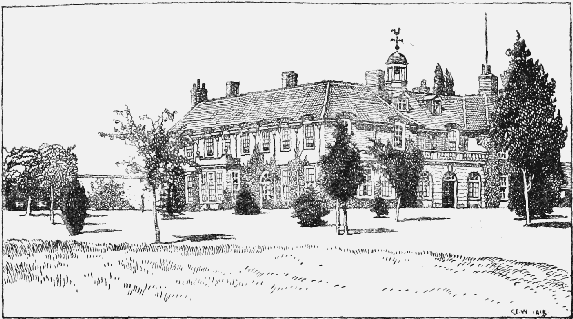
Mowbray. Gules a lion argent.
Manors
At the date of the Domesday Survey BRAFFERTON was divided between two fees. One carucate of land, which had been held by Haltor in the reign of Edward the Confessor, was held in 1086 by the Count of Mortain in demesne, (fn. 12) while a 'manor' and 5 carucates were held of the king in chief by Gospatric in both reigns. (fn. 13) By the year 1284–5 the overlordship of both fees had passed to the Mowbray family, (fn. 14) and followed the descent of their manor of Thirsk (q.v.).
In 1284–5 Nicholas de la River was tenant of one knight's fee in Brandsby, Stearsby and Brafferton, (fn. 15) and his land here followed the descent of the manor of Brandsby until the death of Thomas de la River in 1558. Thomas had settled the manor of Brafferton on his natural daughters Thomasina and Elizabeth for life, with remainder to the issue of Elizabeth and contingent remainder to Roger Cholmeley and Jane his wife, another natural daughter of Thomas. (fn. 16) Elizabeth died without issue in 1597, and her nephew Marmaduke Cholmeley, son and heir of Roger and Jane Cholmeley, entered into possession of the manor. (fn. 17) He died without issue in 1602, and was succeeded by his brother Richard. (fn. 18) Richard Cholmeley and all his family were from time to time presented for recusancy. (fn. 19) He died without issue and was succeeded by Thomas, another brother, in 1624. (fn. 20) In 1626 Thomas Cholmeley settled the manor in tail on his son Marmaduke and his heirs, on his marriage to Ursula daughter of Robert Thornton of East Newton. (fn. 21) It was forfeited for the recusancy of Thomas Cholmeley and was leased by the Crown in 1628 for twenty-one years to Thomas Revell. (fn. 22) Though it was afterwards recovered by the Cholmeleys, it was again forfeited during the Civil War, and must have been sold by the Treason Trustees with Brandsby to Gilbert Crouch, who joined in 1656 in a conveyance by Marmaduke Cholmeley to Ralph Rymer. (fn. 23) Rymer was made treasurer of his district during the Commonwealth, (fn. 24) and received a grant of lands at Yafforth and Wickmore, which he had previously rented from Sir Edward Osborne. (fn. 25) He so resented the enforced surrender of these lands at the Restoration (fn. 26) that he joined the 'Presbyterian Rising' of 1663. (fn. 27) He was thereupon attainted, and executed in 1664, (fn. 28) when the manor reverted to the Crown. On 2 March 1664–5 it was leased for ninety-nine years to Sir Thomas Osborne of Keeton, (fn. 29) and on 30 March the lease was bought by Sir Jordan Crosland of 'Harum Haugh' for £2,000. (fn. 30) The Rymers appear to have regained possession of the manor between 1666, when Ralph Rymer, jun., who had been attainted with his father, (fn. 31) was released from York Castle on bail, (fn. 32) and 1668, when Ralph and Thomas Rymer and others sold it to John Cosin, Bishop of Durham, (fn. 33) who was succeeded by his eldest daughter Mary, wife of Sir Gilbert Gerard of Fiskerton, Lincolnshire. (fn. 34) Gilbert Gerard died in 1687, and was succeeded by his son Gilbert, who took the additional name of Cosin. (fn. 35) Sir Gilbert Gerard Cosin conveyed the manor to Brooke Bridges and Ralph Grange in 1687–8, (fn. 36) and in 1690–1 he and his brother and heir Samuel conveyed it to John Lodington and James Whitchurch. (fn. 37) Four years later it was conveyed by the executors of Sir Samuel Gerard to Richard Earl of Burlington and others, trustees under the will of Robert Boyle, fifth son of the first Earl of Cork, who died in 1691, leaving a sum of money to be laid out on the propagation of Christianity among infidels. (fn. 38) The Society for Advancing the Christian Faith in the West India Islands now exercises the manorial rights.
In the reign of Edward the Confessor the Archbishop of York held 5 carucates of land in HELPERBY (Helprebi, xi cent.; Helperbi, xiv cent.; Herperby, Helperbie, xvi cent.), which remained in his possession at the time of the Domesday Survey. (fn. 39) The vill was confirmed to the church of York by Pope Celestine III (fn. 40) in 1194 and formed part of the Liberty of St. Peter.
In 1086 Rayner held these 5 carucates at a rent of 6s. (fn. 41) The first known grant of the manor was that made at the close of the 12th century to Roger de Bavent and Maud his wife and her heirs (fn. 42); it was afterwards confirmed to Andrew de Bavent, her son. (fn. 43) About 1235 the manor of Helperby was granted by Geoffrey Dean of St. Peter's to Bevis son of Alexander de Bayeux and his issue by Isabel daughter of Richard de la River, with contingent remainder to Alexander brother of Bevis for life. (fn. 44) Bevis was succeeded by his son Thomas, and in 1319 John de Bayeux son of Thomas (fn. 45) was lord of Helperby. (fn. 46) In 1336 William de Bayeux, son of John, recovered the manor, which had been wrongfully seized by the king's escheator on the pretext that Bevis, an elder brother of William, had been outlawed. (fn. 47) William died without issue, as did his sister and heir Margaret. (fn. 48) The manor was conveyed in 1344 by John Wacelyn and Hugh Martell in tail to Robert de Rawcliffe and his wife Joan, who claimed to have the interest of Joan, a daughter of Bevis and Isabel. (fn. 49) In 1375, on the ground that the issue of Bevis and Isabel had failed, the dean and chapter recovered the manor, (fn. 50) which they seem to have afterwards held in demesne.
In 1650 the trustees for the sale of church lands sold the manor to Edward Herries, (fn. 51) who in 1655–6 sold it to Ralph Rymer. (fn. 52) At the Restoration it reverted to the church. The manorial rights are now vested in the Ecclesiastical Commissioners.
Tenements and one mill in Raskelf and Helperby were in 1650–1 conveyed to John Lord Belasyse and his heirs by James Earl of Carlisle and his wife Margaret. (fn. 53)
At the time of the Domesday Survey 6 carucates of land at THORNTON BRIDGE (Torenton, xi cent.; Thorneton-super-Swale, xiii cent.; Thorntonbryg, Thornton Briggs, xvi cent.) were held of the king by Gospatric. (fn. 54) By 1284–5 the overlord ship had passed to the Mowbray family. (fn. 55) It followed the descent of their manor of Thirsk (q.v.).
The Mowbray fee in 1284–5 had several mesne lords. The first mesne lordship was held in 1193 by Ranulph de Sules, (fn. 56) who forfeited it for his refusal to pay a forest fine to the king. (fn. 57) It was granted to Hugh de Nevill, who gave it in marriage with his daughter to a certain— de Norfolk. (fn. 58) This fee in Brafferton was said in 1284–5 to be held of Ranulph de Sleys (Sules ?) by Geoffrey de Nevill, of whom it was held by James de Norfolk (Norff'), son of Gilbert de Ilketeshal of Norfolk. (fn. 59) At about this date James de Norfolk released to the tenant in demesne his 9 librates of rent for a yearly payment of 2s. or one sore sparrowhawk. (fn. 60) In 1285 he released to him this rent also, so that the mesne lordship disappeared. (fn. 61)
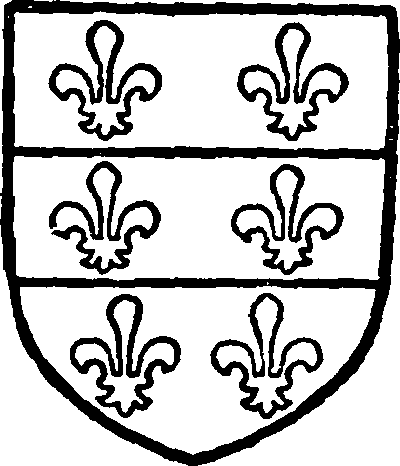
Deyvill. Or a fesse sable with six fleurs de lis countercoloured.
The tenancy in demesne belonged from the 12th century to the family of Deyvill. In 1193 John Deyvill gave the king 40s. that Ranulph de Sules might be summoned to show why he deforced him of land at Thornton Bridge. (fn. 62) John evidently took the side of the barons in 1215, (fn. 63) and was succeeded by his son Robert, (fn. 64) who in 1235 quitclaimed to the Abbot of Byland the fishery in the Swale granted by his father. (fn. 65) Another John Deyvill, the son of Robert, was party in 1280 to an agreement with the Prior of Newburgh by which the prior had the right of distraint on the land of the Deyvills in Cundall and Leckby if they failed to pay rent for tenements in Gargrave. (fn. 66) In return the prior promised to hold a service yearly at Newburgh for the souls of John, Maud his wife, and their heirs and ancestors. In 1284–5 John Deyvill son of John was holding 6 carucates in Cundall and Thornton Bridge. (fn. 67) The younger John seems to have had two daughters, Elizabeth married to Alexander de Leeds, and Margaret, whose husband is not known. (fn. 68) In 1323 he granted the manors of Cundall and Thornton Bridge to Alexander de Leeds and Elizabeth, and gave notice to his tenants that their services were due to Alexander. (fn. 69) Twelve years later both manors were in the possession of Boniface de Leeds, probably son of Alexander. He granted to Alexander his son and Margaret his wife two parts of the manors of Thornton and Cundall, and the reversion of the third part, which was held at the time by Adam de Everingham and his wife as her dower. (fn. 70)
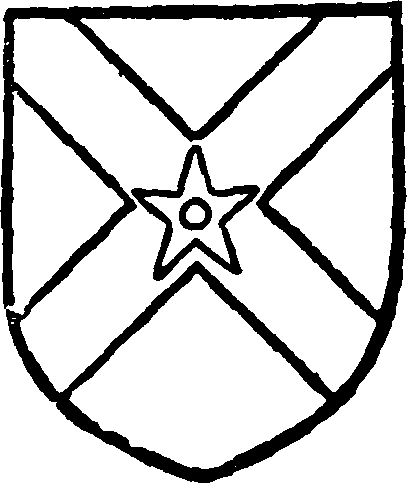
Nevill of Thornton Bridge. Gules a saltire argent with a pierced molet sable thereon.
Alexander and Margaret de Leeds had a daughter and heiress Elizabeth, (fn. 71) who married as her first husband Ralph de Nevill, (fn. 72) a younger son of Ralph Lord Nevill of Raby. He succeeded to the manors held by Alexander de Leeds and became the founder of the family known as the Nevills of Thornton Bridge. His son was Alexander Nevill, (fn. 73) whose son and heir Alexander married Katherine Eure. (fn. 74) The will of the latter, proved in 1457, shows that his affairs were somewhat involved. His executors, 'considerantes dictum defunctum aere alieno multipliciter gravatum ac varia facta et acta per eum in vita sua multiformiter intricata,' refused to undertake the management of his estate. (fn. 75)

Strickland. Sable three scallops argent.
William son of Alexander died in 1468–9, leaving a son William, (fn. 76) who was knighted in 1482. (fn. 77) At his death his estates passed to his son Ralph, who married Anne daughter of Sir William Gascoigne, (fn. 78) and whose heir was his son, another Ralph. (fn. 79) This Ralph married Anne daughter of Christopher Ward of Newby and died without male issue in 1522. (fn. 80) He left three daughters and co-heirs, (fn. 81) Katharine wife successively of Sir Walter Strickland of Sizergh, (fn. 82) Henry Borough (fn. 83) and William Knyvett, (fn. 84) Joan wife of Sir John Constable of Burton Constable, (fn. 85) and Clara, afterwards wife of Thomas Nevill of Holt. (fn. 86) The greater part of Thornton Bridge came into the possession of the Stricklands. (fn. 87) Walter Strickland, son of Sir Walter and Katharine, (fn. 88) succeeded to his mother's share. He was succeeded in 1569 by his son Thomas, (fn. 89) who died in 1612 and was succeeded by his son Robert. (fn. 90) Sir Robert Strickland was deputy-lieutenant of the North Riding and a knight of the shire. (fn. 91) He was a Royalist in the Civil War, holding command of a regiment under the Earl of Cumberland in 1642. (fn. 92) He was succeeded in 1670 by his son Thomas, (fn. 93) the most notable member of the family. Thomas received a commission from Charles I in 1642 to command a company of 114 soldiers of the trained bands. (fn. 94) He afterwards laid down his commission and submitted to the committee for war within the Northern Association, taking the Negative Oath and the Covenant. (fn. 95) In 1649 he compounded for delinquency in engaging in the wars. (fn. 96) In 1665 he was granted the lease of the duties on salt imported from Scotland and beyond the seas for twenty-one years at a rent of £1,800. (fn. 97) There was a regrant of this lease in 1672 at the reduced rent of £1,000. (fn. 98) His daughter Alice, on whom he seems to have settled the manor, was the wife of Sir Walter Kirkham Blount, bart. (fn. 99) She died in 1680, and Thornton Bridge passed, probably by purchase, to Sir Roger Strickland, who, it has been suggested, was a descendant of Walter Strickland, a younger son of that Sir Thomas who died in 1612. (fn. 100) The manor of Thornton Bridge was lost to the Strickland family when Sir Roger, who accompanied James II to Ireland in 1689, was attainted for high treason. (fn. 101) Since this time the manor has been leased by the Crown at various dates. (fn. 102)
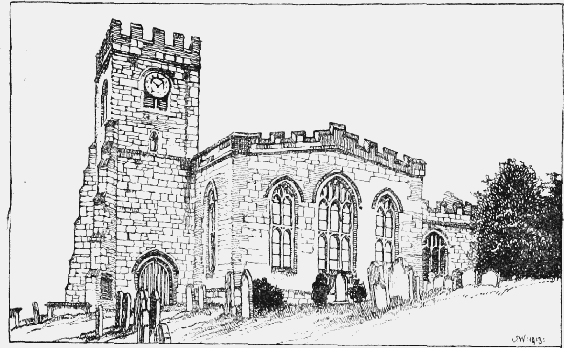
Brafferton Church from the South
Though there is nothing to indicate that Joan the second daughter of Ralph Nevill held lands in Thornton Bridge, it is certain that Clara, her younger sister, had land here. This followed the descent of the manor of Leckby (fn. 103) (q.v.), with which it was sold in 1672 to Sir Robert Long. (fn. 104)
Church
The church of ST. PETER, formerly dedicated to the honour of St. Augustine, (fn. 105) consists of a chancel 31¾ ft. by 17¾ ft. with north and south chapels, making a total width of 46 ft., a modern nave and a west tower, the total length of the church being 79 ft. The measurements are internal.
None of the existing work in the church is of earlier date than the 15th century, to which period belong the chancel and the west tower. The chancel chapels were added in the early years of the 16th century by Ralph Nevill of Thornton Bridge. The mediaeval nave was entirely removed in 1831 and the present structure built in its place, and the church has been restored in more modern times.
The chancel has a 15th-century east window of four lights and is separated on either side from the chapels by arcades of two bays. The chapels are conterminous with the chancel and are faced with ashlar. They were apparently built at the same time (the early 16th century) and are of similar character. The north chapel has a three-light east window and a two-light window in the north wall. On the east wall externally is an inscription in Gothic letters reading 'Soli deo gloria.' The south chapel has likewise a three-light east window and two three-light windows in the south wall. The parapet is embattled and below it on the south wall is the inscription 'Orate [pro] a[nim]a Radulfi Nevvell fundatoris istius cācellarii.' Below are three carved shields and the further words 'et gloria soli deo honor et . . .' The shields are those of Ralph Nevill, his wife (who was daughter and heir of Sir Christopher Ward), and his daughter Katharine wife of Sir Walter Strickland of Sizergh. As Katharine, who died in 1527, was aged twenty-three in 1522, the date of the chapel may be fixed within a few years. The chapels have good parclose screens of oak, which with the reading desk were erected by the Coates family. The nave is an unfortunate example of the age in which it was built and is entirely without interest. The earlier building, destroyed in 1831, had an aisle only on the north side, into which it opened by an arcade of two bays. A plan of the church before the alteration is preserved amongst the churchwardens' accounts of that period. The 15th-century tower at the west end is three stages high and supported by diagonal buttresses. It has an embattled parapet and a three-light west window. The axis of the tower makes a considerable deviation to the north from that of the rest of the church.
The font stands beneath the tower and has a modern stem and base and a 14th-century bowl with a moulded lower edge.
In the north chapel is a stone slab, possibly commemorating a Prior of Newburgh, bearing an incised pastoral staff of early form but no inscription. In the north window of the same chapel is an early 16th-century coat of arms of Ward quartering Nevill of Thornton.
There are six bells, of which the first, third, fifth and sixth were cast by J. Taylor of Loughborough in 1886; the second is inscribed 'Radulphus Nevil armiger, IHS 1598'; and the fourth is mediaeval, inscribed in Gothic characters, 'Jhū (fili) dei miserere nobis,' and having a small shield charged with a quatrefoil.
The plate includes a cup (the date mark probably York, 1658, and inscribed 'R.B., R.W. Churchwardens 1663'), two patens and a flagon of 1869, and two large pewter flagons and as many almsdishes of the same material.
The registers before 1812 are as follows: (i) baptisms and burials 1798 to 1812; (ii) marriages 1798 to 1812.
Advowson
At the time of the Domesday Survey (fn. 106) there was a church on the king's land in Brafferton and a priest. (fn. 107) The patronage belonged to the family of de la River until it was given to Newburgh Priory by Henry de la River before 1226, (fn. 108) the grant being confirmed by William de Mowbray, his overlord. (fn. 109) The Prior and convent of Newburgh obtained licence to appropriate the church in 1316 (fn. 110) and again in 1444. (fn. 111) A vicarage is said to have been ordained in 1446. (fn. 112) The advowson was held by this house until the Dissolution, when it came to the Crown. It was granted by Henry VIII in 1545 to Robert Archbishop of York in exchange for certain manors. (fn. 113) After this time it seems to have belonged alternately to the Crown and the Archbishop of York. (fn. 114) In 1729 it was finally transferred to the Crown by Act of Parliament in exchange for the vicarage of Bishopthorpe. (fn. 115) The vicarage is now in the gift of the Lord Chancellor, while the Ecclesiastical Commissioners possess the rectorial tithes. (fn. 116)
Charities
In 1873 the late Mr. James Coates of Helperby Hall erected a block of buildings comprising an institute, two cottages, cottage hospital and four almshouses—as appears on an inscription over the door of the institute—in memory of his parents, Jonathan and Ann Coates.
Four widows are chosen by the present owner of Helperby Hall, Sir Edward F. Coates, bart., M.P. for the borough of Lewisham, London, who makes them a weekly allowance. The sole control of the charity is vested in the founder's family. The institute is used as a reading room, &c., and the cottage hospital, not being required for that purpose, is let as a dwelling-house.
The Poor's Land consists of 8 a. at Sowerby, purchased in 1789 with £100 bequeathed by will of Mrs. Mary Frewen Turner, and with £132 15s. ancient parish stock. The land is let at £12 a year, which with the dividends on £83 13s. 7d. consols arising from sale of timber was in 1904–5 distributed in money to thirty-five inhabitants of Helperby, fifteen of Brafferton, and two of Thornton Bridge.
An annuity of 10s. is paid by Mr. Miles J. Stapylton for the poor in respect of a charity known as the Myton charity. An annuity of 10s., formerly received in respect of Glauber's charity, has for some years ceased to be paid.
An annuity of 40s. charged in 1723 by will of — Dibble upon Bræme Close for putting to school four children of Helperby is received from Mr. F. J. Haxby Robinson of Easingwold and paid to the managers of the National school.
Miss Mary Lawson, by will, 1882, bequeathed £50 for investment, the income to be applied for the benefit of widows and spinsters, which was augmented by a legacy of £50 by will of Miss Dorothy Lawson. The legacies were invested in £104 8s. 4d. consols, and the dividends, amounting to £2 12s., are distributed among twelve recipients.
In 1896 Christopher Lambert, by deed, settled a sum of stock for the benefit of the poor, subsequently augmented to £150 consols, the dividends of which, amounting to £3 14s. 8d., are duly applied.
The several sums of stock are held by the official trustees.